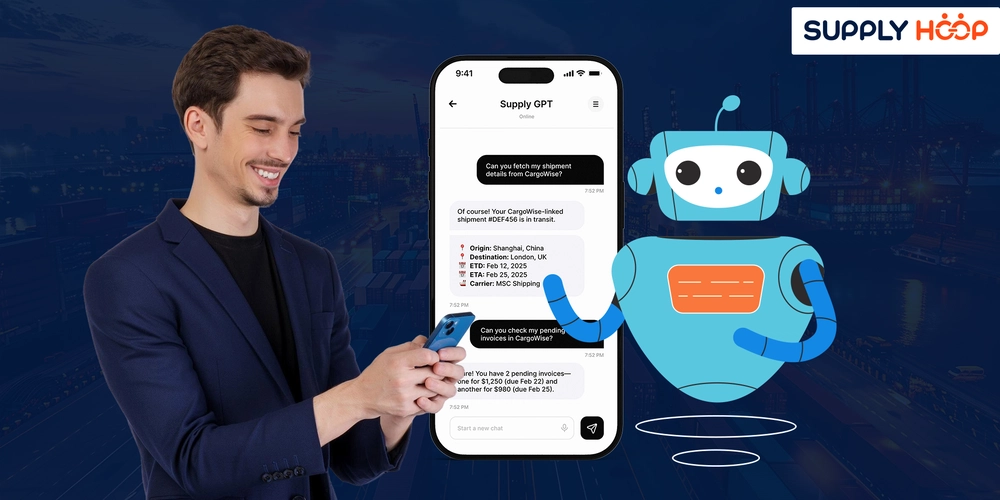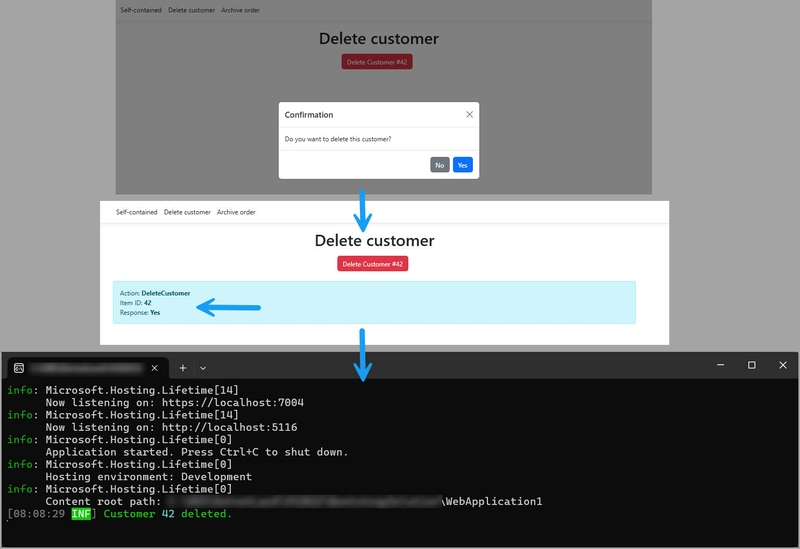Introducing AI in Supply Chain: How Supply GPT Enhances Supply Chain Visibility
In the complicated, high-speed world of global logistics, it is more important than ever to keep transparency throughout each connection of the supply chain. Market needs are expanding, customer expectations are reaching new heights, and disruptions—whether because of geopolitical changes, natural catastrophes, or transportation congestion—are becoming more common. In the midst of all this, one technology is proving to be a game-changer: AI-based virtual assistants designed specifically for the logistics sector. One of these innovations, Supply GPT, is changing the logistics professional's interaction with their data and operations. It's not only another chatbot—it's an AI engine custom-built to deliver unprecedented visibility, intelligence, and automation across the supply chain ecosystem. What Is Supply GPT? Supply GPT is a new-generation virtual assistant created with intimate knowledge of logistics and supply chain processes. As opposed to general AI tools learned on public data, this assistant is specifically designed for freight forwarding, customs brokerage, warehousing, and transportation management operations. It can be easily integrated into logistics ERP platforms like CargoWise, allowing logistics professionals to ask real-time queries, automate document processing, and get predictive insights through natural language. The objective? Break down information silos, minimize manual workload, and support smarter, speedier decisions from end to end of the supply chain. Why Supply Chain Visibility Needs AI Supply chain visibility is not a buzzword—it's a requirement. Organizations with end-to-end, real-time visibility of their inventory, shipments, suppliers, and documentation are better able to manage exceptions and make timely deliveries. Legacy approaches, including spreadsheets, siloed dashboards, and email-based notifications, are no longer adequate. They are reactive, not proactive. They offer historical data, not real-time insights. AI flips that on its head by bringing in: Conversational access to ERP data Live document summarization Automated notification and response Predictive analysis of supply chain activity Through these, logistics professionals can transition from information overload to actionable intelligence—where and when it's required. Key Ways Supply GPT Enhances Supply Chain Visibility 1. Conversational Data Access With Supply GPT, it is no longer necessary for teams to click across several screens or create static reports to get answers. They just ask: "What is the current ETA for shipment SHP-09876?" "List all orders delayed over 2 days last week." "Sum up customs clearance problems for shipments to Germany." Such real-time questions are responded to in seconds, extracting data from systems such as CargoWise or integrated platforms, allowing faster and more informed decision-making. 2. Document Intelligence Each logistics transaction involves a tidal wave of paperwork—bills of lading, commercial invoices, packing lists, compliance documents, and the like. Processing them by hand is laborious and error-ridden. Supply GPT streamlines this through robust document intelligence capabilities: Pulls key data points from unstructured documents Identifies inconsistencies or empty fields Condenses multi-page documents into actionable abstracts This saves time in processing and enhancing compliance accuracy across borders and regulatory landscapes. 3. Predictive Analytics and Exception Alerts In addition to tracking, Supply GPT assists teams in anticipating and averting problems. Through examination of historical patterns as well as current inputs, it is able to: Predict delays caused by weather, port blockages, or capacity constraints Identify risky shipments or partners Suggest rerouting or alternative suppliers in case of a problem Proactive exception handling avoids minor glitches from becoming severe disruptions, conserving time, money, and customer confidence. 4. Tailored Workflows and Use Case Flexibility Each logistics firm has unique priorities. Some specialize in international freight forwarding, while others handle last-mile delivery, warehousing, or customs operations with heavy compliance requirements. Supply GPT is adaptable. Common applications are: Ocean freight tracking and predicted container arrival analysis Notification of delivery delays for e-commerce orders Procurement cycle monitoring of inbound logistics Vendor performance metrics and service-level agreement tracking This flexibility makes it fit into current work processes without making companies shift the way they function. 5. Integration with Leading ERP Systems For logistics ERPs like CargoWise, Supply GPT is even more potent. Through direct integration, it offers: Natural language search across modules (forwarding, customs, transport) Automated extraction of critical data from shipments,

In the complicated, high-speed world of global logistics, it is more important than ever to keep transparency throughout each connection of the supply chain. Market needs are expanding, customer expectations are reaching new heights, and disruptions—whether because of geopolitical changes, natural catastrophes, or transportation congestion—are becoming more common. In the midst of all this, one technology is proving to be a game-changer: AI-based virtual assistants designed specifically for the logistics sector.
One of these innovations, Supply GPT, is changing the logistics professional's interaction with their data and operations. It's not only another chatbot—it's an AI engine custom-built to deliver unprecedented visibility, intelligence, and automation across the supply chain ecosystem.
What Is Supply GPT?
Supply GPT is a new-generation virtual assistant created with intimate knowledge of logistics and supply chain processes. As opposed to general AI tools learned on public data, this assistant is specifically designed for freight forwarding, customs brokerage, warehousing, and transportation management operations. It can be easily integrated into logistics ERP platforms like CargoWise, allowing logistics professionals to ask real-time queries, automate document processing, and get predictive insights through natural language.
The objective? Break down information silos, minimize manual workload, and support smarter, speedier decisions from end to end of the supply chain.
Why Supply Chain Visibility Needs AI
Supply chain visibility is not a buzzword—it's a requirement. Organizations with end-to-end, real-time visibility of their inventory, shipments, suppliers, and documentation are better able to manage exceptions and make timely deliveries.
Legacy approaches, including spreadsheets, siloed dashboards, and email-based notifications, are no longer adequate. They are reactive, not proactive. They offer historical data, not real-time insights. AI flips that on its head by bringing in:
- Conversational access to ERP data
- Live document summarization
- Automated notification and response
- Predictive analysis of supply chain activity
Through these, logistics professionals can transition from information overload to actionable intelligence—where and when it's required.
Key Ways Supply GPT Enhances Supply Chain Visibility
1. Conversational Data Access
With Supply GPT, it is no longer necessary for teams to click across several screens or create static reports to get answers. They just ask:
- "What is the current ETA for shipment SHP-09876?"
- "List all orders delayed over 2 days last week."
- "Sum up customs clearance problems for shipments to Germany."
Such real-time questions are responded to in seconds, extracting data from systems such as CargoWise or integrated platforms, allowing faster and more informed decision-making.
2. Document Intelligence
Each logistics transaction involves a tidal wave of paperwork—bills of lading, commercial invoices, packing lists, compliance documents, and the like. Processing them by hand is laborious and error-ridden.
Supply GPT streamlines this through robust document intelligence capabilities:
- Pulls key data points from unstructured documents
- Identifies inconsistencies or empty fields
- Condenses multi-page documents into actionable abstracts
This saves time in processing and enhancing compliance accuracy across borders and regulatory landscapes.
3. Predictive Analytics and Exception Alerts
In addition to tracking, Supply GPT assists teams in anticipating and averting problems. Through examination of historical patterns as well as current inputs, it is able to:
- Predict delays caused by weather, port blockages, or capacity constraints
- Identify risky shipments or partners
- Suggest rerouting or alternative suppliers in case of a problem
Proactive exception handling avoids minor glitches from becoming severe disruptions, conserving time, money, and customer confidence.
4. Tailored Workflows and Use Case Flexibility
Each logistics firm has unique priorities. Some specialize in international freight forwarding, while others handle last-mile delivery, warehousing, or customs operations with heavy compliance requirements. Supply GPT is adaptable.
Common applications are:
- Ocean freight tracking and predicted container arrival analysis
- Notification of delivery delays for e-commerce orders
- Procurement cycle monitoring of inbound logistics
- Vendor performance metrics and service-level agreement tracking
This flexibility makes it fit into current work processes without making companies shift the way they function.
5. Integration with Leading ERP Systems
For logistics ERPs like CargoWise, Supply GPT is even more potent. Through direct integration, it offers:
- Natural language search across modules (forwarding, customs, transport)
- Automated extraction of critical data from shipments, documents, and invoices
- Intelligent prompts and contextual suggestions for operational optimization
This in-built AI layer turns a conventional ERP into a smart, responsive environment where information flows freely and action follows insight.
Transforming Productivity Across Teams
One of the biggest benefits of Supply GPT is the way it maximizes team effectiveness—not by taking someone's job, but by giving them the ability to accomplish more with less effort. From customer service to operations, compliance, and finance, all departments gain.
- Customer Service: Get shipment status, exceptions, or delivery estimates immediately to answer questions quicker.
- Operations: Track shipment milestones, anticipate bottlenecks, and prevent them.
- Finance: Match invoices, confirm PO and GRN status, and raise alerts to differences in real-time.
Redundancy reduces to make way for problem-solving, strategy, and customer satisfaction.
Future-Proofing the Supply Chain with AI
As international trade becomes increasingly interconnected, the room for error diminishes. Supply chain professionals need to transition from reactive firefighting to predictive, strategic planning. AI, and more specifically specialized tools such as Supply GPT, enable this transition.
What makes this solution different is its domain specificity—it recognizes logistics lingo, procedures, and requirements. It knows the language of freight, customs, warehousing, and compliance. And more significantly, it adapts to the business, learning from every encounter.
Conclusion
The future of supply chain visibility is not fixed dashboards and hand-assembled reports. It's dynamic, smart, and chat-like. Supply GPT illustrates this trend by putting actionable insights at every team member's fingertips.
Regardless of whether you're looking to automate documentation, minimize exceptions, or simply make better day-to-day decisions, this AI aid can be your most valuable ally.
Adopting smart solutions today makes us better equipped for tomorrow. And with the power of AI, the supply chain is not just visible—it's intelligent.




























![[Webinar] AI Is Already Inside Your SaaS Stack — Learn How to Prevent the Next Silent Breach](https://blogger.googleusercontent.com/img/b/R29vZ2xl/AVvXsEiOWn65wd33dg2uO99NrtKbpYLfcepwOLidQDMls0HXKlA91k6HURluRA4WXgJRAZldEe1VReMQZyyYt1PgnoAn5JPpILsWlXIzmrBSs_TBoyPwO7hZrWouBg2-O3mdeoeSGY-l9_bsZB7vbpKjTSvG93zNytjxgTaMPqo9iq9Z5pGa05CJOs9uXpwHFT4/s1600/ai-cyber.jpg?#)











































































































































![[The AI Show Episode 144]: ChatGPT’s New Memory, Shopify CEO’s Leaked “AI First” Memo, Google Cloud Next Releases, o3 and o4-mini Coming Soon & Llama 4’s Rocky Launch](https://www.marketingaiinstitute.com/hubfs/ep%20144%20cover.png)





























































































































![[FREE EBOOKS] Machine Learning Hero, AI-Assisted Programming for Web and Machine Learning & Four More Best Selling Titles](https://www.javacodegeeks.com/wp-content/uploads/2012/12/jcg-logo.jpg)








































































![Rogue Company Elite tier list of best characters [April 2025]](https://media.pocketgamer.com/artwork/na-33136-1657102075/rogue-company-ios-android-tier-cover.jpg?#)








































































_Andreas_Prott_Alamy.jpg?width=1280&auto=webp&quality=80&disable=upscale#)





























































































![What’s new in Android’s April 2025 Google System Updates [U: 4/18]](https://i0.wp.com/9to5google.com/wp-content/uploads/sites/4/2025/01/google-play-services-3.jpg?resize=1200%2C628&quality=82&strip=all&ssl=1)










![Apple Watch Series 10 Back On Sale for $299! [Lowest Price Ever]](https://www.iclarified.com/images/news/96657/96657/96657-640.jpg)
![EU Postpones Apple App Store Fines Amid Tariff Negotiations [Report]](https://www.iclarified.com/images/news/97068/97068/97068-640.jpg)
![Apple Slips to Fifth in China's Smartphone Market with 9% Decline [Report]](https://www.iclarified.com/images/news/97065/97065/97065-640.jpg)


































































































































